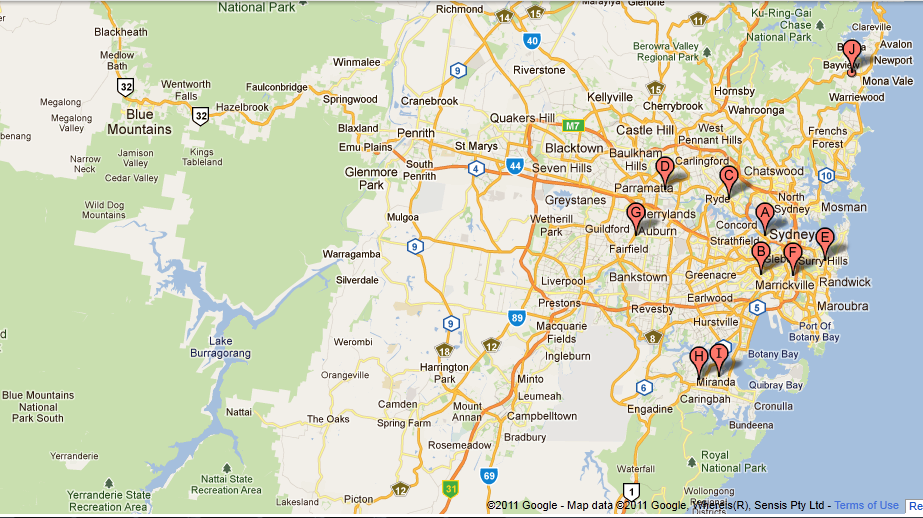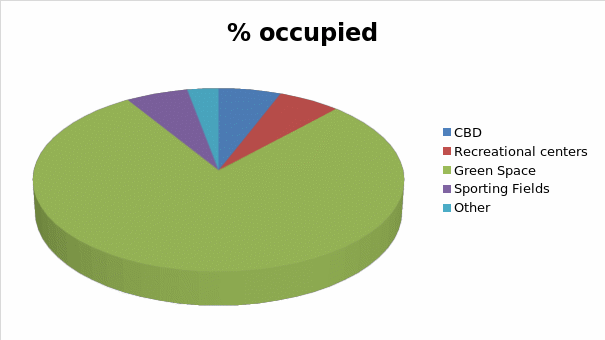Introduction
The importance of an ecosystem as a component of sustainable development cannot be overstated. An ecosystem comprises both the living and non-living organisms in an area. These include animals, plants, buildings, and water among others. No specific size can be used to describe an ecosystem. In the recent past, plenty of emphasis has been put on the importance of green spaces as well as parks in creating a balance in the ecosystem within the urban areas and their surrounding areas. They help in providing a better quality of air, places for enjoying cool weather, and hence support the development of good health. This report explores how Sidney has been able to incorporate the aforementioned in its planning structure.
Sydney is lucky to have both nature and civilizations within its coverage. It prides itself in plenty of recreational, safari parks, and small forests, which are desirable points of relaxation as well as adventure for the population of Sydney as well as visitors (City of Sydney, 2011). Each council within Sydney is responsible for the parks within its jurisdictional areas. This report explores the nature of the ecosystem in Sydney by identifying the tree coverage, various types of green spaces, and available parks among others to fully describe Sydney’s ecosystem
Materials and method
The preparation of this report was aided by both secondary and primary data. Sydney is very large and hence to provide more realistic results within the short time frame, these reports narrowed down to Sydney’s inner West including Centennial Park and Hyde Park areas. Observation formed a key part of the approach used in this research. The researchers spent some time walking through the park and collecting information important to this study. These include information on trees, the occupants as well as the existing recreation facilities. Additionally, newspapers and newspaper magazines were used to extract information. Internet sources were extremely helpful in establishing the amount and types of green spaces covering the area of study. Additionally, a Google map was used to illustrate the area studied and its corresponding structure.
Results
A critical review of existing literature material including websites and documentations reveal that more than 245 parks exist in Sydney covering more than 9 km2 (City of Sydney, 2011). Most of the parks are found in the city which covers more than 10% of the land area in Sydney. Initially, most parks were intended for private purposes but were later many of them were transformed into plant collections as well as sightseeing locations for the public (City of Sydney, 2011). SGS (2010, p. 5) that most of the species considered threatened and rare are found in Australian parks. These include birds, reptiles, mammals, plants as well as fishes.
General overview of Sydney
The diagram below shows the general overview of Sydney and its corresponding ecosystem.

From the diagram, it can be seen that Sydney and its ecosystem is made up of a rich ecosystem comprising of parks, a lake, sea, mountains and forests. It’s a general representation of a wholesome ecosystem characterized by the interesting natural and artificial phenomenon. To further explore the situation in Sydney, the map is further evaluated to establish the coverage of green areas. The suburb areas have more green coverage as compared to the central urban location. The green coverage area in the suburbs is not only extensive but also forms a majority of the area. Interestingly, a closer look at the map confirms information provided by documentation and literature materials reviewed that within the urban areas the parks are evenly distributed across the urban centre. This illustrates the importance the planners and policy formulators of the urban centre attach to the creation of a balanced ecosystem. Additionally, critical observation of the map reveals that the area is endowed with natural greens and other features that help in balancing its ecosystem.
According to the City of Sydney report (2011), the highest percentage of green parks is recorded in farmland areas located in Sydney’s suburbs. Generally, land that has not been developed amounts to approximately 70% of the land area in Sydney. National parks also claim a large chunk of the green spaces in Sydney amounting to approximately 15% of the total green area in Sydney (City of Sydney, 2011, p. 23). Other areas that constituted the green environment in Sydney include sporting fields and recreational parks. Interestingly, the larger population of urban dwellers in Sydney prefers to stay in areas around sporting fields and recreational parks (City of Sydney, 2011, p. 24). In general, features distribution in the larger Sydney area is illustrated in the table below:
Figure 2: Sydney ecosystem.
The information is illustrated in the pie chart below:

The case in the CBD area is significantly different from the overall scenario described above. The findings are represented in the table below and consequently represented in the pie chart.
Figure 5: Ecosystem in Sydney’s urban area.
These findings are best represented in the pie chart below:

The figures essentially show that while the wider Sydney area enjoys an appreciable amount of green coverage, the urban area has been largely encroached by development initiatives. Artificial recreational parks, sports grounds form part of the green space in the area. However, naturally occurring vegetation also constitute part of the green vegetation in urban areas. However, the content of green coverage is relatively small compared to the large developed areas.
The tree composition in parks and naturally occurring vegetation within the urban centers was observed to be vast in nature with over 500 species recorded. Other than shrubs, herbs, and ferns, the most common species are listed in the table below (City of Sydney, 2011, p. 29):
- Cluster Pine
- Coral tree
- Broadleaf paperback
- Flooded gum
- Holm Oak
- Monterey Pine
- Moreton Bay Fig
- Norfolk Island Pine
- Port Jackson fig
The trees found in the parks have a height between 12 and 60 meters. However, shrubs and other forms of vegetation have much reduced heights. Other than vegetation animals, other than those in national parks found within the urban centre include butterflies, squirrels, and birds among others. The human activity in the parks is mainly restricted to Cycling, walking, yoga, playing soccer, reading books and jogging. However, some people were observed to use the recreational parks for social gatherings. Other worth mentioning things found in the parks included playgrounds, seats and flower fields.
Bicentennial Parks are just but one of the many parks in Sydney. Ranging from Rozelle bay to the end of Glebe to Chapman road, the park forms 100-hectare of wetland ecosystem (Centennial parklands, 2011). It is estimated that the parks accommodate more than 130 bird species within their ecosystem. Like many other parks in Sydney, it also has artificial hills, and landfills occupied by planted trees. The parks are also characterized by mangroves which harbor specifies of frogs that have long been declared endangered (Centennial parklands, 2011). The parks in Sydney have both exotic and native trees among their vegetation.
Discussion
This researches investigation revealed the importance attached to green spaces by the population of Sydney. The green spaces benefit the population in myriad ways. The parks are characterized by plenty of trees, seats as well as recreational facilities to facilitate social activities within the parks. Other than the parks, natural occurring vegetation also form a smaller part of the green space with Sydney’s urban setting. The case in the suburbs is relatively different with a large portion of the green space being used for farming activities. However, national parks also constitute a larger percentage of the green spaces in the Sydney suburbs. In general, the green space serves a diverse population. The importance of green spaces in population health cannot be ignored. It’s important to highlight that other than providing recreational grounds for physical enjoyment and mental relaxation; they also help in air purification. Interestingly, the green space in Sydney’s urban area also acts as a center for the preservation of endangered species. This is confirmed by the large species of birds accommodated as well as the endangered frogs found in these parks. Generally, the parks have been able to successfully help in creating an ecosystem balance within the area.
References
Centennial parklands. (2011). Centennial parks. Web.
The city of Sydney. (2011). City of Sydney Open Space System: Context Urban Context. Web.
City of Sydney. (2011). Live green city. Web.
City of Sydney. (2011). Parks & Open Spaces Plans of Management. Web.
Google maps. (2011). Sydney Open spaces. Web.
SGS. (2010). SGS Economics and Planning has led a team to develop the City of Sydney’s 2030 vision for a green, global and connected Sydney. Sydney: SGS Economics and planning.